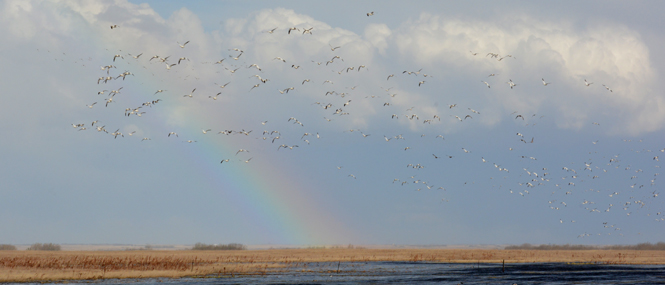Flock after flock of Snow Geese flew over a field south of Coronation on April 11. The geese are part of the migration which sees millions of waterfowl and other birds returning to the area on their path to spring breeding grounds. Beth Causley
For the first time ever in Alberta, the Snow Goose along with Ross’s Goose are on the list of waterfowl that can be hunted during spring in Alberta.
The hunt, according to Environment Canada’s website, goes from March 15 to June 15, 2016. The hunting regulations can be found for Alberta there and in it is stated that the daily limit is 50 and there is no possession limit.
According to Alberta Conservation Association (ACA) and Environment Canada since the mid 1970 the goose population has increased massively and due to the influx in numbers are causing staggering damage to human agriculture and their own habitat, particularly their arctic breeding grounds north of the timberline in Greenland and the northeastern tip of Siberia.
While numbers vary depending on the conservation site, the numbers of Snow Geese and Ross’s Geese are in the millions and need to be culled to help reduce the impact the birds have on the land they return to in the spring.
Environment Canada says that the increase in Snow Goose populations was primarily human-induced. Changing farming practices supplied a reliable, highly nutritious food source for migrating and wintering geese. Combined with the safety found in refuges, this improved nutritional status led to increased survival and higher reproductive rates for Snow Geese.
These populations have become so large that they are affecting the plant communities at staging areas and breeding grounds on which they and other species rely. Grazing and grubbing by geese not only permanently removes vegetation, but also changes soil salinity, nitrogen dynamics and moisture levels.
The result is an alteration or elimination of the plant communities. Although the Arctic is vast, the areas that support migrating and breeding geese and other companion species are limited in extend, and some areas are likely to become inhospitable for decades.
Increasing crop damage is another undesirable consequence of the growing goose populations. Environment Canada also states that the decimation of the areas occupied by nesting geese result in exposure of mineral substrate and peat, when during nesting and spring staging, a large portion of their diet is composed of the roots and rhizomes of sedges and grasses.
They also said that because of the damage being done by foraging geese, they have seen a dramatic decline in small mammal abundance around dense nesting colonies and that the areas that are preferred by Ross’s Geese, previously degraded by Snow Geese, may slow the recovery of those areas due to the ongoing effects of foraging and nest building.
The smaller bill of the Ross’s Goose may allow them to crop vegetation more closely to the ground than the Snow Goose, adding to the intensity of grazing pressure.
While there are concerns that hunters will misidentify the bird for another, say a pelican or a whooping crane, ACA says that there hasn’t been a single documented case of a hunter shooting a crane or pelican in Quebec, Manitoba or Saskatchewan, which have had a spring goose hunt for 16 years.
Mistaking the Snow Goose for a swan is another concern so knowing how to identify birds is important.
There are regulations about hunting waterfowl so make sure to check with local Fish and Wildlife offices and websites like My Wild Alberta to make sure that you are prepared and up to date before going out hunting.
Originally Published April 15, 2015 in the ECA Review
